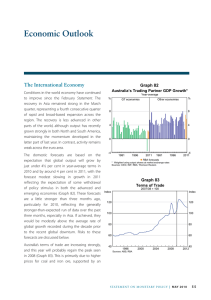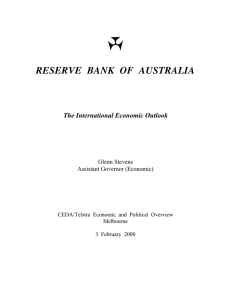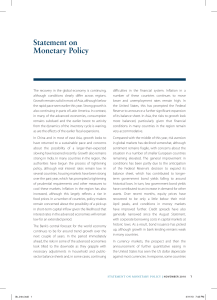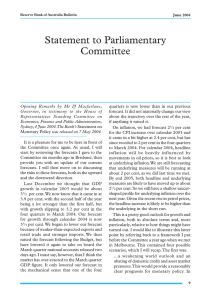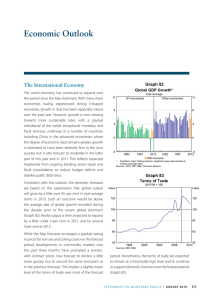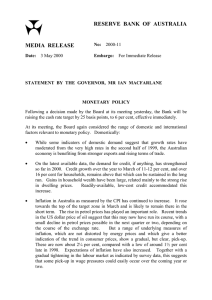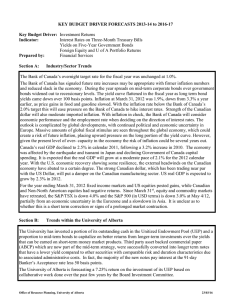Economic Outlook The International Economy Graph 88
advertisement
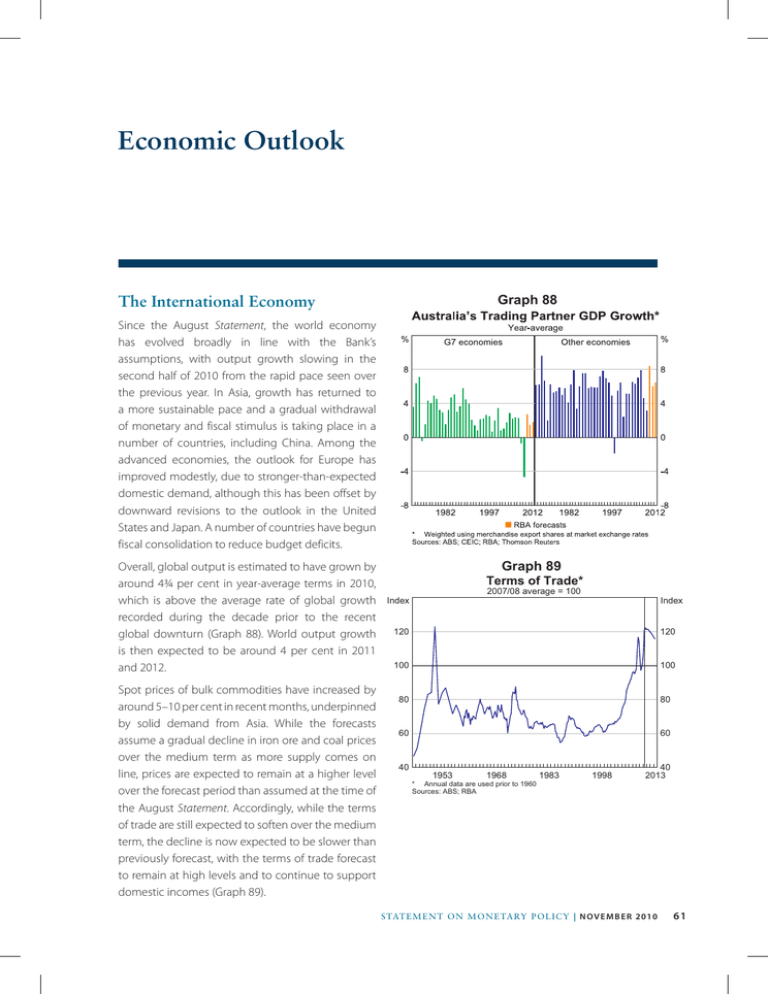
Economic Outlook Graph 88 The International Economy Since the August Statement, the world economy has evolved broadly in line with the Bank’s assumptions, with output growth slowing in the second half of 2010 from the rapid pace seen over the previous year. In Asia, growth has returned to a more sustainable pace and a gradual withdrawal of monetary and fiscal stimulus is taking place in a number of countries, including China. Among the advanced economies, the outlook for Europe has improved modestly, due to stronger-than-expected domestic demand, although this has been offset by downward revisions to the outlook in the United States and Japan. A number of countries have begun fiscal consolidation to reduce budget deficits. Overall, global output is estimated to have grown by around 4¾ per cent in year-average terms in 2010, which is above the average rate of global growth recorded during the decade prior to the recent global downturn (Graph 88). World output growth is then expected to be around 4 per cent in 2011 and 2012. Spot prices of bulk commodities have increased by around 5–10 per cent in recent months, underpinned by solid demand from Asia. While the forecasts assume a gradual decline in iron ore and coal prices over the medium term as more supply comes on line, prices are expected to remain at a higher level over the forecast period than assumed at the time of the August Statement. Accordingly, while the terms of trade are still expected to soften over the medium term, the decline is now expected to be slower than previously forecast, with the terms of trade forecast to remain at high levels and to continue to support domestic incomes (Graph 89). Graph 89 Terms of Trade* 2007/08 average = 100 Index Index 120 120 100 100 80 80 60 60 40 1953 1968 1983 1998 40 2013 * Annual data are used prior to 1960 Sources: ABS; RBA STATE ME N T O N MO N E TARY P O L ICY | n o v e m b e r 2 0 1 0 61 Domestic Activity The central forecast for the domestic economy is similar to that at the time of the August Statement. The outlook is positive, supported by the expected strong growth in investment in the resources sector, the income boost flowing from the elevated level of commodity prices and ongoing solid population growth, albeit at a reduced pace relative to the high rate of around a year ago. With the economy having limited spare capacity, there is likely to be an increase in inflationary pressures over the forecast period. The risks around these forecasts are discussed below. The central forecasts are summarised in Table 15 and are based on the technical assumption that the exchange rate remains at its current level – which is around 6 per cent higher on a trade-weighted basis since the August Statement – and that the cash rate moves broadly in line with market expectations. As noted in previous Statements, the latter assumption does not represent a commitment by the Board to any particular path for policy. GDP growth is expected to be around trend for 2010. It is then forecast to pick up to a slightly above-average pace in 2011 and through to the end of the forecast period in June 2013. This would probably result in a tightening in capacity in the economy after the period of below-average growth in 2008 and 2009. In year-ended terms, GDP growth is forecast to be around 3½ per cent over 2010 and to strengthen to 3¾ per cent over 2011 and 4 per cent over 2012. In year-average terms, GDP is forecast to grow by 3½ per cent in 2010/11, 3¾ per cent in 2011/12 and 4 per cent in 2012/13. Conditions are likely to vary significantly across the economy, with growth expected to be strongest in mining and related sectors. The central forecast for GDP growth is broadly unchanged since the August Statement, with the contractionary effect of the exchange rate appreciation being broadly offset by the forecast higher terms of trade. The expected rebalancing of growth from public to private demand appears to be occurring. Public spending was prominent in driving aggregate demand over 2009/10, but the period when stimulus spending was contributing to GDP growth looks to have ended, and the winding down of stimulus programs is expected to subtract from GDP growth in the period ahead. The pick-up in private demand in the central forecast is driven primarily by business investment. Even after applying a significant discount to stated expectations, there is likely to be a further ramp-up in mining investment to a historically very high level; large LNG projects are taking place in Queensland and Western Australia and other significant resources projects in iron ore, coal and LNG are in various stages of planning. Outside of the mining sector, liaison indicates that a degree of caution still characterises firms’ spending decisions, with confidence and investment intentions around average levels. While the higher exchange rate is having an effect on some industries, the general investment outlook remains positive, with solid internal funding from profits, and equipment investment expected to gradually pick Table 15: Output Growth and Inflation Forecasts(a) Per cent, over year to quarter shown GDP growth Non-farm GDP growth CPI inflation Underlying inflation June 2010 3.3 3.3 3.1 2¾ Dec 2010 3½ 3¼ 2¾ 2½ June 2011 3½ 3¼ 2¾ 2½ Dec 2011 3¾ 3¾ 2¾ 2¾ June 2012 3¾ 3¾ 2¾ 2¾ Dec 2012 4 4 3 3 June 2013 4 4 3 3 (a) Technical assumptions include A$ at US$1.00, TWI at 74, WTI crude oil price at US$87 per barrel and Tapis crude oil price at US$90 per barrel Sources: ABS; RBA 62 R eserv e Ban k o f Australia up following the temporary weakness associated with the end of the tax incentives. In the household sector there is also a degree of cautiousness still evident in borrowing and spending decisions, with growth in household deposits running ahead of borrowing. Notwithstanding this, robust growth in income and the strong labour market are expected to support growth in real household consumption over the forecast period. Growth in exports is forecast to be above the rate of the past decade, with significant new capacity for resource exports coming on line. In contrast, nonresource export growth is expected to be modest, reflecting the high real exchange rate and policy changes in the education sector. Import growth is expected to be strong, reflecting the exchange rate appreciation and robust growth in domestic demand, particularly in investment in the resources sector which has a significant imported content. Growth in GDP is expected to be associated with continued above-average growth in the labour force over the forecast period, reflecting both solid growth in the working-age population and a further modest increase in the participation rate. Labour market conditions are expected to tighten gradually over the forecast period. Inflation The medium-term outlook for inflation is broadly unchanged. Underlying inflation eased to around 2½ per cent over the year to the September quarter, its lowest outcome since 2005 and around 2 percentage points below its peak two years earlier. This overall decline has been broadly in line with the Bank’s inflation forecasts since early 2009, and reflects the significant moderation in demand pressures and capacity utilisation through late 2008 and 2009, the slowing in wage growth and the exchange rate appreciation since early 2009. The bulk of the disinflationary effects from the slowdown are likely to have passed, and the subsequent strengthening in economic conditions and the labour market is expected to lead to a gradual pickup in inflation in the medium term. In year-ended terms, underlying inflation is forecast to remain around 2½ per cent until mid 2011, before picking up gradually to 3 per cent by late 2012. Inflation in non-tradable items is expected to remain firm, with significant contributions from rent, utilities and other housing costs. To some extent this will be offset by relatively moderate inflation for tradable items, partly reflecting the ongoing effects of the exchange rate appreciation on imported consumer prices. The near-term forecast for year-ended inflation is a little lower than at the time of the August Statement. This is largely due to the recent appreciation of the exchange rate and the effect of the slightly lower-than-expected September quarter outcome. Headline CPI inflation was 2.8 per cent over the year to the September quarter. Year-ended CPI inflation is expected to remain above underlying inflation in the near term, at around 2¾ per cent, largely due to the increase in tobacco excise earlier in the year and high utilities price inflation. Risks As always, there are risks in both directions around the forecasts, although overall these risks are viewed as being evenly balanced. Domestically, one key risk concerns the expected pick-up in resources investment. Given the complexity and large scale of some of the projects, there is inevitably some uncertainty about the timing and pace of spending, which could alter the expected profile of GDP growth. Another uncertainty relates to the possibility that the current caution in behaviour of consumers and firms outside of the mining sector could wane. If this occurred in conjunction with a significant ramp-up in mining projects, capacity pressures would emerge, wage growth would rise more quickly than currently STATE ME N T O N MO N E TARY P O L ICY | n o v e m b e r 2 0 1 0 63 expected and there would be a significant risk that inflation expectations could increase to levels inconsistent with the medium-term target. Internationally, developments in China and east Asia have grown in importance for Australia, and it is quite possible that growth there could surprise on the upside as it has for much of the past decade. In the case of the advanced economies, the risks that are more obvious are to the downside. Some countries still have fragile banking sectors, many face the task of consolidating their public finances, and the process of household balance sheet repair still has some way to run in a number of countries. Another factor influencing the outlook for Australia is the exchange rate. Since the August Statement, the Australian dollar has appreciated by around 6 per cent on a trade-weighted basis, to be 45 per cent above its trough in late 2008 and at its highest level in real terms in the post-float period (Graph 90). The appreciation that has taken place over recent years has had a dampening effect Graph 90 Real Exchange Rate* Post-float average = 100 Index Index 125 125 100 100 75 1985 1990 1995 2000 * Uses the latest core inflation rates Sources: ABS; RBA; Thomson Reuters 64 R eserv e Ban k o f Australia 2005 75 2010 on some sectors of the economy, particularly in import-competing and export-oriented industries such as manufacturing, farming, tourism and education. However, the appreciation has occurred in the context of strong global demand for Australia’s resource exports and the significant interest rate differential with the major advanced economies. If developments in global financial markets resulted in a significant further appreciation that was unrelated to these factors, it would likely result in both growth and inflation being lower than in the central forecast. R
